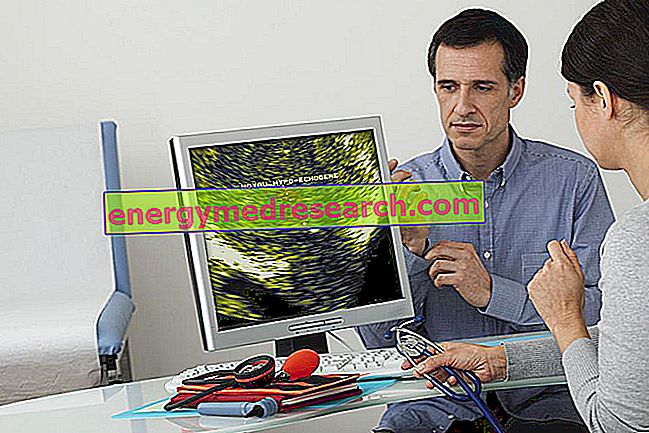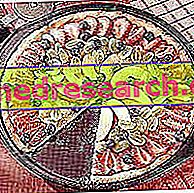Key points
Behçet's disease (or syndrome) is a rare and complex multi-systemic disorder involving small and large blood vessels. It is a chronic / recurrent vasculitis with multi-organ involvement, potentially fatal.

Behçet's disease: causes
Unproven hypothesis: the Behçet disease derives from an abnormal autoimmune response, triggered in turn by an infectious agent (not yet identified). Risk factors: environmental and genetic factors, cigarette smoking
Behçet's disease: symptoms
Aphthae and oral ulcers; cataract, glaucoma and uveitis; genital sores / scars; papulo-pustular skin lesions; aneurysm, arrhythmias, edema of the legs and arms and deep vein thrombosis; Diarrhea, dysphagia, flatulence and gastric ulcers; Brain and nervous system inflammation; Arthritis and arthralgia
Behçet's disease: drugs
The treatment currently available is aimed at merely controlling symptoms: Cortisonics, Colchicine, Antagonists of tumor necrosis factor, NSAIDs.
Behçet's disease
Behçet's disease is a complex, rare multisystem syndrome of unknown etiology, characterized by inflammation involving the blood vessels of each anatomical site. Although not fully demonstrated, it appears that Behçet's disease has an autoimmune origin. However, it seems that a network of environmental and genetic factors heavily affects the onset of the disease.
Involving the entire reticulum of blood vessels, the characteristic symptoms of Behçet's disease can be multiple and heterogeneous: oral ulcers, ocular inflammation, CNS disorders, rashes, genital sores and joint pains. However, the symptomatic picture derived from Behçet's disease varies from subject to subject.
The specific treatment of Behçet's disease aims essentially at the prevention of serious complications, including blindness.
Behçet's disease bears the name of the discoverer. In 1937 the Turkish dermatologist H. Bechet observed the recurrence of a symptomatic triad in many patients: oral ulcers, frequent genital sores, and ocular inflammation (uveitis) were considered three characteristic aspects of the same disease.
Incidence
Behçet's disease is more common in patients aged between 15 and 45; in particular, in subjects under the age of 25 the target of the disease appears to be the eye. Despite what has been said, Behçet's syndrome may also appear during the pediatric age and in senescence.
Recent statistics reported in the Scientific journal Expert opinion on pharmacotherapy show that Behçet's disease manifests itself with a prevalence of 0.3-6.6 cases per 100, 000 healthy inhabitants, with a marked prevalence in China, Japan and the Middle East in gender. Males seem to be more affected than women.
Causes
As mentioned in the beginning, a specific cause implicated in Behçet's disease has not yet been identified. The syndrome is neither contagious nor infectious and cannot be transmitted by sexual contact. However, it seems that the etiopathogenesis of the syndrome derives from an abnormal autoimmune response: the organism, by mistakenly recognizing some (healthy) cells as "foreign and potentially dangerous", triggers an exaggerated defensive reaction against them, causing damage. It is thought possible that an infectious agent - or another element not yet known - can trigger this exaggerated autoimmune inflammatory response, whose main target is the vessel wall.
It should not be forgotten that some environmental and genetic factors may predispose the patient to Behçet's disease: the hypothesis that there is a genetic correspondence with the HLA-B51 antigen and - in the Caucasian race - with HLA-B57 seems to be confirmed.
Among the factors predisposing to Behçet's Syndrome we recall cigarette smoking: the chemical substances contained in it can somehow damage the DNA, therefore predispose the patient to the disease.
General symptoms
Being a systemic disease, Behçet's syndrome can also spread to all visceral organs - lung, stomach, intestine etc. - up to involving muscles and nerves.
Distinctive symptoms of Behçet's disease vary from subject to subject. Moreover, even the frequency of appearance of the signs is purely subjective: some patients constantly complain of the presence of the disease, while in others the symptoms reappear less frequently.
The localization of the disease greatly conditions the intensity of the symptoms: the most involved anatomical sites are mouth, eyes, genitals, skin, vascular system, digestive system, brain and joints.
Table of symptoms
| LOCATION OF INFLAMMATION | CHARACTERISTIC SYMPTOMS |
| Mouth | Mouth ulcers (characteristic sign of Behçet's disease) that turn into painful oral ulcers. The lesions heal in 1-3 weeks and tend to recur frequently |
| Eyes | Uveitis (→ ocular redness, local pain, photophobia, blurred vision), ipopion (pus accumulation in the anterior ocular chamber), cataract, glaucoma, retinal detachment, blindness (serious complications) |
| genitals | Genital sores at scrotum / vulva level → reddened, painful, ulcerative and scarred lesions |
| Skin | Reddened, painful subcutaneous nodules, acne-like nodules (folliculitis), papulo-pustular lesions |
| Vascular system | Inflammation of veins and arteries (vasculitis) → redness, pain and edema in the lower and upper limbs. When the inflammatory process involves the main arteries, the patient runs the risk of aneurysm, thrombophlebitis and deep vein thrombosis. Arrhythmias, pericarditis, vasculitis of the coronary arteries are also possible |
| Digestive and intestinal system | Diarrhea, dysphagia, abdominal pain, flatulence, gastrointestinal bleeding, gastric ulcerative lesions |
| Brain | Brain and nervous system inflammation → headache, confusion, loss of balance, stroke, meningoencephalitis |
| Joints | Arthritis, arthralgias → Localized swelling and pain in the knees, elbow, ankles, wrists, back |
Although less common than the symptoms listed above, patients with Behçet's syndrome experience seizures.
Behçet's disease can give poor prognosis: in fact, the possible rupture of vascular aneurysms and heavy neuronal lesions can put the patient's life at serious risk.
Diagnosis
The diagnostic assessment of Behçet's disease is rather complex, considering the heterogeneity of the symptoms and the affinity with many other pathologies.
The peculiarities of this disease - oral ulcers and genital ulcers - may suggest this condition. Detection of inflammation of the pulmonary arteries may also be a lit indicator of Behçet's syndrome.
Particular is the diagnostic analysis called "patergic test" ( Pathergy test ): the doctor proceeds by injecting a physiological solution intradermally or by simply pricking the patient's skin with a sterile needle. If a nodule forms at that precise point after 48 hours, Behçet's syndrome is conceivable. The mechanical stimulus exerted by the needle favors the formation of a pustular lesion: in such circumstances, the patient will be considered positive for Behçet's disease. An additional biopsy can support the diagnosis.
No diagnostic test can definitively ascertain or disprove Behçet's disease with absolute certainty. The hypothesis can be demonstrated through the symptomological investigation and the verification of some tests.
Therapy
Unfortunately, since it is a rare disease, large pharmaceutical companies do not seem to consider Behçet's syndrome a target of interest for investing in research.
However, the currently available treatment is aimed at symptom control, IF AND WHEN they appear. The drugs used in therapy are purely anti-inflammatory. Colchicine, corticosteroids, immunosuppressants and NSAIDs seem to attenuate symptoms excellently:
- Cortisonics: applied directly to damaged skin (oral ulcers, genital lesions, eye diseases, etc.) reduce inflammation. They are probably the most widely used drugs in Behçet's disease therapy. However, there is no proven evidence on the effectiveness of these drugs in reducing the progression of the disease.
- Colchicine (eg. COLCHICINA LIRCA): a medicine used to treat gout. In Behçet's disease, the drug is useful for reducing joint pain.
- Immunosuppressants (eg azathioprine, chlorambucil or cyclophosphamide): exercise their therapeutic activity by suppressing the immune system (hyperactive), thereby reducing inflammation.
- Tumor necrosis factor antagonists (eg etanercept or infliximab): currently little in use, the use of these drugs should be evaluated in patients suffering from Behçet's disease with severe cutaneous, genital / oral (ulcers and papules) and ocular involvement .
- NSAIDs: temporarily reduce pain and inflammation
Administration of anticoagulants or antiplatelet agents does not appear to report any positive outcome in the prevention of vascular complications (eg deep vein thrombosis) in the context of Behçet's disease.



